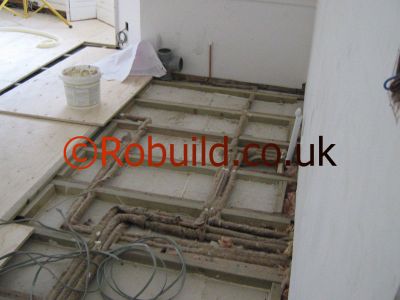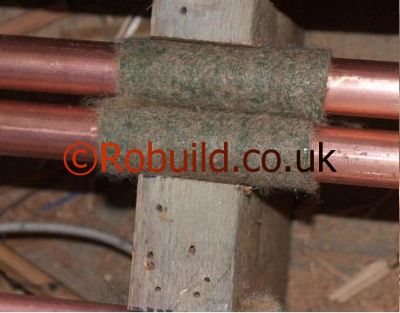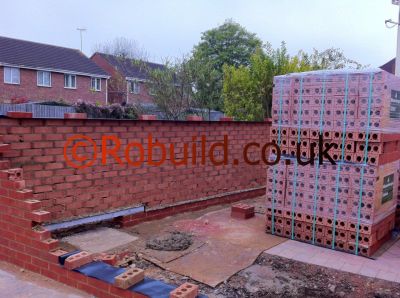Sometimes newly built house extensions and loft conversions are build with lighter materials than older ones, and the result is less, not more, insulation against unwanted noise. Older houses have a greater amount of protection because of their thick brick walls, but badly fitting doors and windows and uninsulated roofs all enable noise to enter. But the cure for the noise problem is not simply a question of shutting out the outside world. Interior noises, such as vibrating pipes, banging doors and footsteps reverberating throughout the house all contribute towards discomfort. Installing sound insulation in your home can be cheap and simple, or involved and expensive. It depends on the source of the noise (or noises if you are particularly unfortunate) and the extent to which you wish to remove it. Bear in mind, however, that it is practically impossible to stop excessive noise completely, though you can make it acceptable.
Controlling noise
The most effective way of overcoming noise is to eliminate or reduce it at its source. This will obviously be impossible if your problem is traffic or aircraft noise, but many irritating internal noises that are transmitted through the structure of the house can be stopped with little effort. One of the most common forms of unwanted internal sound is that made by parts of the plumbing system, particularly WCs, you may prefer to insulate the roof instead of the floor. This keeps the loft warm. If your loft is used as an attic room, and has floorboards, you will have to do this anyway. The easiest and cheapest way to insulate an attic roof is to use fibreglass matting similar to that used for a loft floor or rolls of acoustic insulation.

It has to be held in place by hardboard nailed to the rafters. The same rule as before applies about width: the matting should be slightly wider than the space between the rafters. It should not stick out at the ends, however, or it will get in the way of the hardboard. A simpler, but less efficient way to insulate the roof is to omit the matting and nail up insulation board instead of hardboard. Many types of insulation board are available. The types backed with aluminium foil conserve the most heat, but cost more than the others. storage cisterns refilling. In many cases a satisfactory reduction in noise can be achieved by simply attaching a length of plastic pipe (if one is not already fitted) from the ball valve outlet to near the bottom of the cistern. This will enable incoming water to discharge below the waterline and not splash on to it. Another method to cut down the noise is to fit a ‘silent’ ball valve. Another common source of noise in the plumbing system is vibrating pipes. This can usually be cured by fixing resilient pads, such as felt or rubber, either between the support clips and the wall to which they are fastening the pipe, or by using them as a sleeve between the pipe and the fixing clips. Also check that there is room for the pipes to expand where they pass through ceiling joists or partition walls, and that pipes to central heating radiators do not rub against the floorboards; when you turn on the heat, they will squeak as they expand.

Resilient pads can also be used to help stop noise from large musical sources, such as pianos or large stereo speakers, being carried into other rooms.
Though most of such noise is airborne, and needs different treatment, some of it can be carried by the building structure—sound travels surprisingly well along, or through, some surfaces. This element of the sound can be reduced by standing the piano on resilient pads, or fitting a similar baffle between a speaker and the floor or wall. Noise caused by footsteps and banging doors can also be a source of irritation and can often be limited quite easily. Impact noises from footsteps can be reduced by laying a resilient floor finish such as cork, rubber, foam-backed vinyl sheet or thick-pile carpet on an underlay.
The noise of doors closing can be muted by fitting a self-adhesive strip to the rebate of the door frame, so that the door is cushioned when it is closed. The methods described above can successfully cut down much structure-borne sound, but excessive noise, whether it is internal or external, carried through the structure of the house or airborne, requires more extensive treatment. For really effective sound insulation, the inside of the roof should be lined, and the floor covered with glass fibre, or mineral wool. Sound insulation.
External noise
External noise is in the form of airborne sound, and in most situations attention to the windows and external doors will have the most effect in preventing it entering the house. Most noise enters buildings through the windows. If the noise is not excessive, merely sealing any gaps, however small, between the frame and the wall opening with a mastic filler or suitable cover strip, and fitting draught excluders, may reduce the noise to a satisfactory level. Fitting heavier glass will also have an effect on the insulation, but if the noise problem is severe, then it will often be necessary to fit double windows. The type of double glazing usually fitted for heat insulation is not very effective as a sound barrier, as it normally has only a narrow gap between the two panes of glass. To be really effective, the window should consist of two separate frames of 6mm float glass with a wide air space between. This should preferably be about 203mm-228mm (8in- 9in)—a gap of less than 100mm (4in) will not be effective. The sides of the air space should be lined with sound-absorbent material, such as 13mm (^in) fibre board, which should preferably be mounted on battens with a small air space behind. To prevent condensation occurring on the inside of the outer pane, some silica gel crystals can be placed on the bottom to absorb moisture, it is no use leaving the usual anti-condensation hole in the inside frame, because this will let sound through—and insulation is only as good as its weakest point. For the most efficient sound insulation, a double window should be permanently sealed and ventilation provided by mechanical means or by a window facing a quieter direction. This will not be convenient in many situations, but inner window units can be obtained which slide open. With any system that is not permanently sealed, fit draught excluders to the outer window, and ensure that the joint between the frame and the walls is properly sealed. The other major route through which sound will enter the house is through the external doors. Whatever you do, some sound will inevitably enter this way as it is not possible, of course, to permanently seal the doors. Noise can be minimized, however, by fixing a flexible draught strip to the bottom edge of the door, which will ‘take up’ irregularities in tr floor surface, and by fitting resilient foam strips into the rebate. The joint around the door frame should be sealed as for windows.
If additional soundproofing is required, building a porch which totally encloses the door will provide an effective sound barrier, a large volume of ‘dead’ air—as well as having many other uses.

In some houses, particularly older ones, sound can penetrate through the roof. A covering of glassfibre or mineral wool laid between the joists will provide both sound and heat insulation and so would be a worthwhile investment. Also cover any gaps in the eaves with insulation board or wood battens. As an alternative to lining the ceiling with insulation materials, or in addition to it if the noise problem is excessive, you can fix plasterboard or insulation board to the underside of the rafters if the roof is unlined. (To stop any leaks or dirt from disfiguring the lining, a layer of building paper, well lapped at joints, is a good idea.)
Internal noise
Although most unwanted sound will probably come from outside the house, it is often desirable to install some form of sound insulation to reduce noise within the house itself—as anyone with a houseful of young children will know! Before embarking on major, and perhaps expensive, changes, first consider whether the careful use of sound absorbent materials will be adequate for your needs. When a sound is made in a room, the ear first hears the direct sound, and then that reflected from the walls, floor and ceiling. This reflected sound reinforces the direct sound (it all takes place within a fraction of a second) and is called reverberation. The larger the room and the harder and more reflective its surfaces, the more reverberation will occur.
Adding sound-absorbent material reduces the effect and helps to reduce the intensity of the sound passing through to adjoining rooms. In most cases, the best place to add absorbent material is the ceiling, as carpets, curtains and upholstered furniture all contribute towards sound absorption. The most common type of absorbent material suitable for ceilings is acoustic tiles. Various types are available. They are usually 300mm (12in) or 600mm (24in) square and are made of ordinary wood fibre, mineral fibre, or special lightweight plasters. They are light in weight and most can be attached to the ceiling with a suitable adhesive, although some require pinning as well.
Acoustic tiles come in a variety of patterns, such as regularly spaced holes, random holes, continuous slots and broken slots. The purpose of all forms is to expose the maximum area of absorbent surface to the sound. It is important not to destroy the texture of the surface by filling it in with paint. Most of these tiles are already decorated, but if further decoration is required, two thin coats of emulsion paint Similar materials are also available in the form of boards. These come in standard sizes, like plasterboard, and have to be pinned or screwed through the existing ceiling into the joists. It will help to locate the position of the joists and mark them with pencil lines on the existing ceiling first before offering up the boards. An alternative method is to attach 50mm x 25mm (2in x lin) battens to the ceiling first, and then fix the boards to them. The gap between the acoustic boards and the original ceiling will slightly increase the sound absorption properties. Sound absorbents are, however, limited in their effectiveness, and it may be necessary to take other steps to cut down the level of internal noise.
Insulating walls and ceilings
Generally, walls transmit mostly airborne sound, and floors both airborne and structure-borne sound. The denser a material is, the less readily it will vibrate, so the denser and thicker the wall, the more effective it is as an insulator. In existing houses it is not usually possible to increase the density of a dividing wall significantly, and improvement in sound insulation must be achieved in other ways. The sound insulating properties of a solid partition wall can be considerably increased by lining it with plasterboard or other building board on timber battens or studs. A 25mm (lin) thick layer of resilient quilt—fibreglass or mineral wool—should be sandwiched between the masonry and the battens. When fixing the battens or studs, use as few masonry nails as possible to keep direct contact with the masonry wall to a minimum. It is essential that all gaps in the board surface, and between it and adjoining walls, ceilings and so on, are filled as noise can penetrate through the smallest hole. Timber stud partition walls are poor sound insulators—the board panels act like large speaker diaphragms. The sound transmission can, however, be greatly reduced by forming a double stud partition.

In this, two sets of alternating studs, each faced with plasterboard or similar building board, are separated by a resilient quilt which winds in and out of the studs. The nature of sound transmission through floors is more complex, as both structure -borne impact noise and airborne noise occur.
Sound is passed through the floor itself, and the structural floor members transmit noise to the walls on which they bear. If impact noise through a suspended floor is severe, and cannot be satisfactorily reduced by the use of a resilient floor covering, then you may have to install a floating floor. The floor surface is attached to 50mm (2in) square battens which rest on the floor joists, a 25mm (lin) thick continuous layer of quilt, such as acoustic glassfibre or mineral wool, being first laid over the joists. The quilt should be turned up at the edges of the floor to isolate the floor surface from the walls. Once the quilt has been laid, the battens can be placed in position and lightly nailed to the joists. This nailing is purely to hold the battens in position as you lay the floor surface. It is essential that these nails are removed progressively from the battens as you nail the floor covering down, otherwise the effectiveness of the insulation will be reduced. Make sure that the nails you use to fix the floor covering to the battens will not penetrate the quilt or joists.
If you have installed a floating floor, it will be necessary to remove a certain amount of wood from the bottom of any doors because of the raised level. A ramp will also be required to avoid a ‘step’ down to any adjacent floor surface. A suspended floor can be made more resistant to airborne noise by increasing its weight. A common way of doing this is to lay a heavy ‘pugging’, such as a 50mm (2in) thick layer of dry sand, between the joists. First check with your local building inspector, however, that your joists will be adequate to support the additional weight. Sand is very heavy. In many cases, the ceiling lining will not be strong enough to carry the weight of the sand layer, so it will be necessary to attach a suitable platform between the joists first. This can be 13mm (^in) chipboard positioned on supports nailed to the sides of the joists.

This method of insulating suspended floors can, of course, be combined with a floating floor to give insulation against both structure-borne and airborne noise. It is also a good idea, as the floorboards will be up, to check that there are no gaps where the joists pass through a partition wall —another way for noise to be transmitted. Fill in any gaps with mortar.
Sound insulation and Soundproofing builders in London





